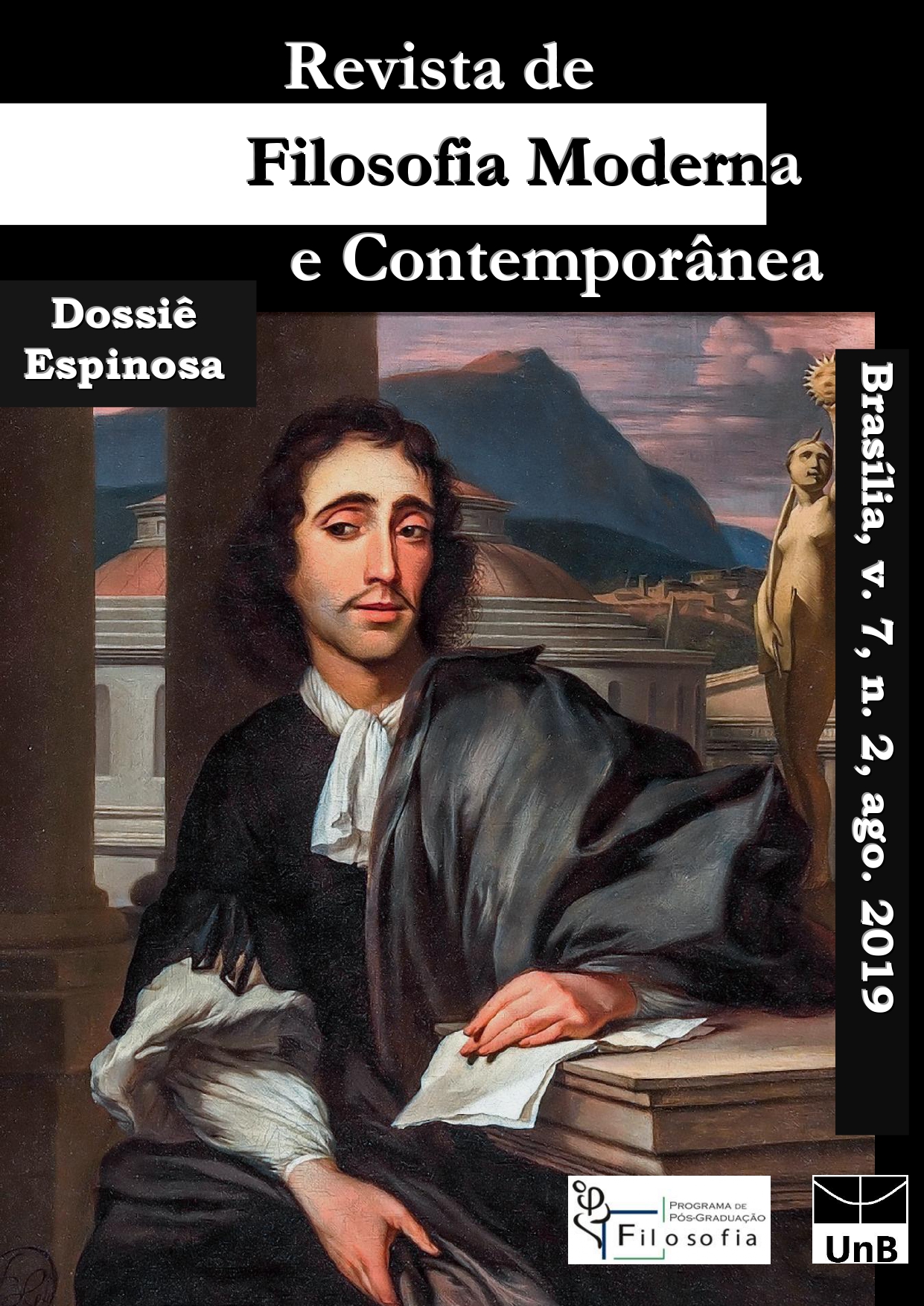De Dicto e De Re: Um Experimento Brandomiano sobre Kierkegaard
DOI:
https://doi.org/10.26512/rfmc.v7i2.24797Palavras-chave:
Kierkegaard, Brandom, Reconstrução Racional, Metafilosofia, OntologiaResumo
A recente virada histórica no interior da filosofia analítica tem contribuído para o crescimento no interesse acerca do procedimento da reconstrução racional, cuja validade ou importá‚ncia, a despeito de ter exemplos paradigmáticos em Frege e Russell, não foi sempre um consenso. Entre os filósofos analíticos pioneiros nesse movimento, Robert Brandom merece especial destaque: seu trabalho sobre Hegel e o Idealismo Alemão têm despertado a atenção tanto sobre a exegese do filósofo de Jena, quanto acerca de suas possíveis contribuições para problemas atuais. Assim, este trabalho tem como objetivo expor o método de Brandom baseado na distinção entre inferências de dicto e de re. Num segundo momento, faço um exercício de aplicação de tal método a Kierkegaard, explicitando seus comprometimentos ontológicos evidenciando tal abordagem como uma valiosa ferramenta para a história da filosofia.
Downloads
Referências
BEANEY, Michael. Frege: making sense. London: Duckworth, 1996.
____. “Analytic Philosophy and History of Philosophy: The Development of the Idea of Rational Reconstruction” in RECK, E. (ed.) The historical turn in analytic philosophy, New York, Palgrave Macmillan, 2013, pp. 231-260.
____. “Historiography, Philosophy of History and the Historical Turn in Analytic Philosophy” in Journal of the philosophy of history, vol. 10, 2, 2016, p. 211-234.
BERTO, F. Existence as a Real Property ”“ The Ontology of Meinongianism, Dordrecth, Springer, 2013.
BRANDOM, R. Making it explicit: reasoning, representing, and discursive commitment. Cambridge, Mass: Harvard University Press, 1994. (MIE)
____. Tales of the mighty dead ”“ historical essays in metaphysics of intentionality, Cambridge: Harvard University Press, 2002. (TMD)
CAPLAN, B. “Ontological Superpluralism,” Philosophical Perspectives, 25.1: 2011, pp. 79”“114.
DUMMETT, M. Frege: Philosophy of Language, Cambridge: HUP, 1973.
FERREIRA, G. “Kierkegaard Descends to the Underworld: Some remarks on the Kierkegaardian appropriation of an argument by F. A. Trendelenburg”. Cognitio, vol. 14, n. 2, 2013, pp. 235-246.
____. “‘The philosophical thesis of the identity of thinking and being is just the opposite of what it seems to be’ : Kierkegaard on the relations between Being and Thought”. Kierkegaard Studies Yearbook, 2015, pp. 13-31. (DOI: 10.1515/kierke-2015-0103).
____. “‘O que nosso tempo mais precisa’: Kierkegaard e o problema das categorias na filosofia do século XIX, Kriterion, vol. 58, n. 137, 2017, pp. 333-350. (DOI: 10.1590/0100-512x2017n13706gfs).
FREGE, G. Die Grundlagen der Arithmetik, eine logisch mathematische Untersuchung über den Begriff der Zahl. Introduction. Breslau: W. Koebner. Transl. by M. Beaney in M. Beaney (ed.). The Frege Reader. Oxford: Blackwell, 1997, p. 84-91.
GABRIEL, M. Fields of sense ”“ a new realist ontology, Edinburgh: EUP, 2015.
GARBER, D. “What’s philosophical about the history of philosophy” in SORREL, T; ROGERS, G. A. J. (eds.) Analytic philosophy and history of philosophy, Oxford: OUP, 2005, pp. 129-146.
KIERKEGAARD, S. Concluding unscientific postscript ”“ vol. 1, Princeton, New Jersey: Princeton University Press, 1992. (CUP)
_____. Philosophical Fragments; Johannes Climacus, or De omnibus dubitandum est. New Jersey: Princeton University Press, 1985. (PF)
LENZ, M. “Did Descartes read Wittgenstein? ”“ Towards a Conceptual Geography”, available at https://www.academia.edu/35021042/Did_Descartes_Read_Wittgenstein_Towards_a_Conceptual_Geography, 2017.
LÆRKE, M., SMITH, J., SCHLIESSER, E. Philosophy and Its History: Aims and Methods in the Study of Early Modern Philosophy. Oxford: Oxford University Press, 2013.
MCDANIEL, K. “Ways of being” in CHALMERS, D.; MANLEY D.; WASSERMAN, R. (eds.). Metametaphysics: New Essays on the Foundations of Ontology, Oxford University Press, 2009.
____. The fragmentation of being, Oxford: OUP, 2017.
MEINONG, A. Theorie de l’objet et Présentation personnelle, Paris: Vrin, 1999.
MERCER, C. “The Contextualist Revolution in Early Modern Philosophy”. Journal of the History of Philosophy, 57(3), pp. 529”“548, 2019 (doi:10.1353/hph.2019.0057).
MILLER, B. The fullness of being ”“ a new paradigm for existence, Notre Dame: UND Press, 2002.
QUINE, W. ‘Quantifiers and propositional attitudes’. Journal of Philosophy, 53, 1956, 177-187.
____. “Existence and Quantification,” in Ontological Relativity and Other Essays, Columbia University Press, 1969.
RECK, E. H. The historical turn in analytic philosophy. Basingstoke, Hampshire New York, NY: Palgrave Macmillan, 2013.
REDDING, P. “The Analytic Neo-Hegelianism of John McDowell & Robert Brandom” in HOULGATE, S.; BAUR, M. (eds.) A companion to Hegel, Oxford: Blackwell, 2011, pp. 576-593.
RUSSELL, B. A critical exposition of the philosophy of Leibniz, New York: Routledge, 2005.
____. The philosophy of logical atomism, Oxford: Routledge, 2010.
THONHAUSER, G. Ein rätselhaftes zeichen ”“ zum verhältnis von Martin Heidegger un Søren Kierkegaard, Berlin: De Gruyter, 2016.
TURNER, J. “Ontological pluralism”. The Journal of Philosophy, vol. 107, 2010, pp. 5-34.
WEBB. C. “Kierkegaard's Critique of Eudaimonism: A Reassessment”. Jour. of Relig. Eth., 45: pp. 437-462, 2017 (doi:10.1111/jore.12185).
Downloads
Publicado
Edição
Seção
Licença
Direitos Autorais para artigos publicados nesta revista são do autor, com direitos da primeira publicação para a revista. Em virtude dos artigos aparecerem nesta revista de acesso público, os artigos são de uso gratuito, com atribuições próprias, em aplicações educacionais e não-comerciais.


